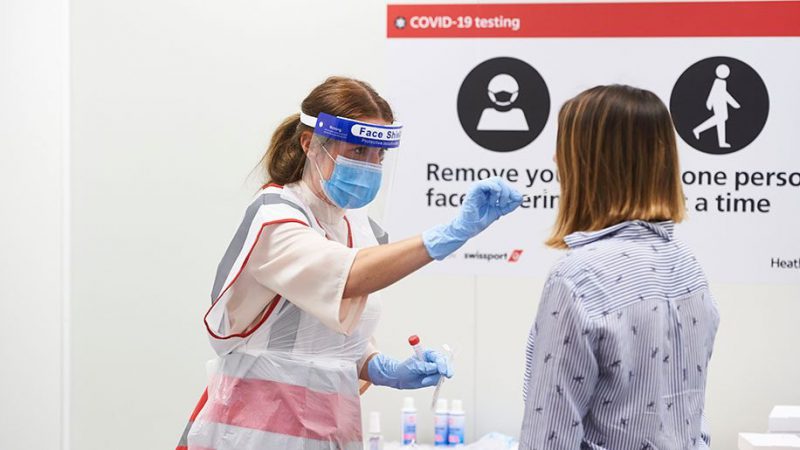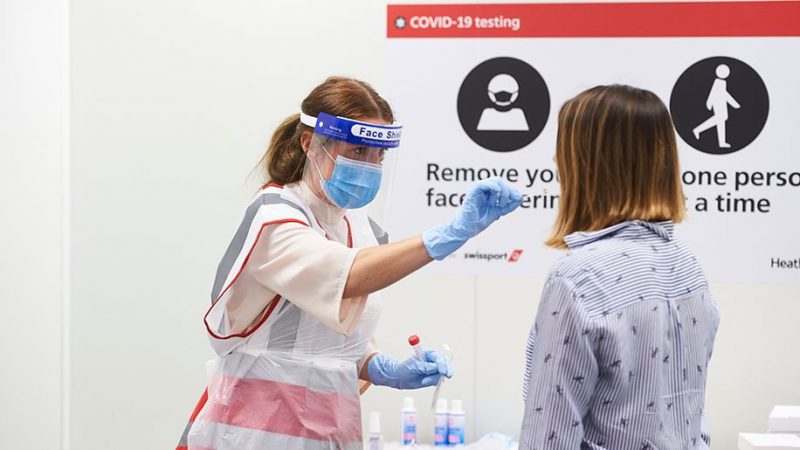Study Finds UK Has “Significantly Understated” the Efficacy of Testing On Arrival
Research concludes government’s argument against passenger testing based on “flawed and outdated” theoretical models
October 22, 2020


As the aviation industry in the UK continues to push for testing regimes to replace the country’s current quarantine policy, an independent analysis has just been released, concluding the government is significantly underestimating the effectiveness of air passenger testing programs.
The independent review of the initial research that underpins the government’s position was commissioned by a consortium of airlines, airports and industry organizations: Virgin Atlantic, IAG, TUI, Heathrow, MAG, Collinson, Airlines UK and IATA.
In June, a Public Health England (PHE) paper estimated that testing on arrival would only catch 7 percent of virus cases. The government continues to rely on the PHE estimate, and as a result, has rejected the various plans airports have put in place to offer testing on arrival to reduce or even eliminate the 14 days quarantine policy, which has caused considerable damage to the travel industry.
The new analysis was conducted by Edge Health, Oxera and Dr Kit Yates, co-director of the Centre for Mathematical Biology at the University of Bath. The analysis reviewed the papers from PHE, the London School of Hygiene & Tropical Medicine (LSHTM) and the Animal and Plant Health Agency (APHA) that form the basis of the UK government’s current quarantine policy.
The analysis has found ‘significant methodological concerns’ in work by PHE, which means the detection rates for passenger testing on arrival are being ‘significantly understated.’
The analysis concludes:
“The PHE paper is based on a theoretical model and is not calibrated to real-world data. It does not consider actual infection rates in the country of origin and therefore fails to provide any real insight into the relative risk that inbound travelers pose to the UK population.”
“The PHE model assumes that all travelers who are infected and detectable with a test prior to departure do not board flights to the UK. Therefore, the 7 percent cited by the government only accounts for travelers who become detectable during the course of their flight. Instead, Edge Health and Oxera estimate that up to 63 percent of infected passengers attempting to enter the UK could be prevented from doing so with a testing scheme – vastly higher than the 7 percent figure offered by PHE.”
Unlike 30-plus countries, including Germany and Italy, the UK has not introduced any form of traveler testing for COVID-19, instead implementing a 14-day quarantine policy and establishing ‘travel corridor’ countries and islands that are exempt – meaning travelers do not have to isolate. This policy is in part based on the conclusions of PHE paper that testing on arrival at an airport would identify only 7 percent of virus cases.
The review also identified shortcomings with the LSHTM and APHA papers.
The LSHTM paper found that an on arrival test would reduce the number of infectious travelers released into the community by about 45 percent, and the APHA paper quotes detection rates of 39.6 percent for a testing on arrival program.
In contrast, Edge Health and Oxera estimate that up to 63 percent of infected passengers attempting to enter the UK could be prevented from doing so with an on arrival testing scheme.
The new analysis also questions the assumption by both PHE and LSHTM of 100 percent compliance with quarantine. According to evidence from SAGE, only around 20 percent of those reporting symptoms of COVID-19 in England are fully self-isolating. This therefore “should be considered in determining how to open up safe travel to and from the UK.”
In addition, it says that “the effectiveness of testing regimes should take account of the demographics of infected people in a country of origin, and particularly the demographics of those people who are likely to fly. The PHE model does not do this.”
The papers were also subjected to more technical criticism, since all three were “based on a simulation modeling technique known as Monte Carlo simulation.” The review says that “it is important to align the assumptions and the outputs with real-world evidence, which is currently lacking in the three papers’ approach. In addition, the assumptions in the three papers vary considerably and, in a number of cases, are not based on the most recent empirical evidence.”
“The papers assume that the objective of the testing strategy would be to reduce the risk of ‘seeding’ community transmissions from flight passengers to zero. However, the government has established travel corridors based on an acceptable level of risk, rather than zero. These two positions are inconsistent.”
Oxera and Edge Health have shared this analysis for consideration by the UK government’s Global Travel Taskforce, which is expected to report its findings to the Prime Minister in early November.
George Batchelor, cofounder and director of Edge Health, said: “The way in which the PHE model is set up means that only a tiny proportion of infected passengers – those who become symptomatic or are asymptomatic but detectable by a PCR test during the flight – can be detected at arrival.
“This means the widely quoted 7 percent excludes anyone who is in theory detectable or symptomatic before the flight takes off. This evidently isn’t the case, and it leads to an underestimation of the effectiveness of testing on arrival (the 7 percent figure), raising serious questions about its role in informing government policy on passenger testing.”
Michele Granatstein, Partner at Oxera and Head of the Aviation practice, said: “All three papers are based on theoretical simulation models. As with all models, the outputs are only as good as their inputs. Since there may be no consensus in the empirical evidence regarding certain input assumptions, it is therefore very important that outputs are calibrated with real-world evidence from established airport testing regimes.”
And Shai Weiss, CEO, Virgin Atlantic, commented: “Based on a Public Health England paper published back in June, UK government has insisted that testing on arrival at an airport would identify only ‘7 percent’ of COVID-19 cases. Today’s new and independent analysis identifies flawed and outdated assumptions in that modeling, and reveals that testing will capture a vast majority of cases rather than the purported 7 percent, which makes it the right solution.
“We urgently need the introduction of a passenger testing regime here in the UK to safely replace quarantine and support the UK’s economic recovery, which relies on free flowing trade and tourism. Half a million UK jobs depend on a fully functioning aviation industry, therefore it’s vital that policy decisions are based on the latest possible evidence.
“The government’s Global Travel Taskforce should consider this new analysis closely and act on findings to swiftly implement a testing regime which opens up the skies safely, and removes 14-day quarantine. The industry has already shown it can deliver passenger-funded, rapid, on site tests that do not divert vital NHS resources. We are ready to work together, but time is of the essence.”




